There is no information about a technology blog in the provided text. The text appears to be about cultural and historical sites in Tokyo, Japan.
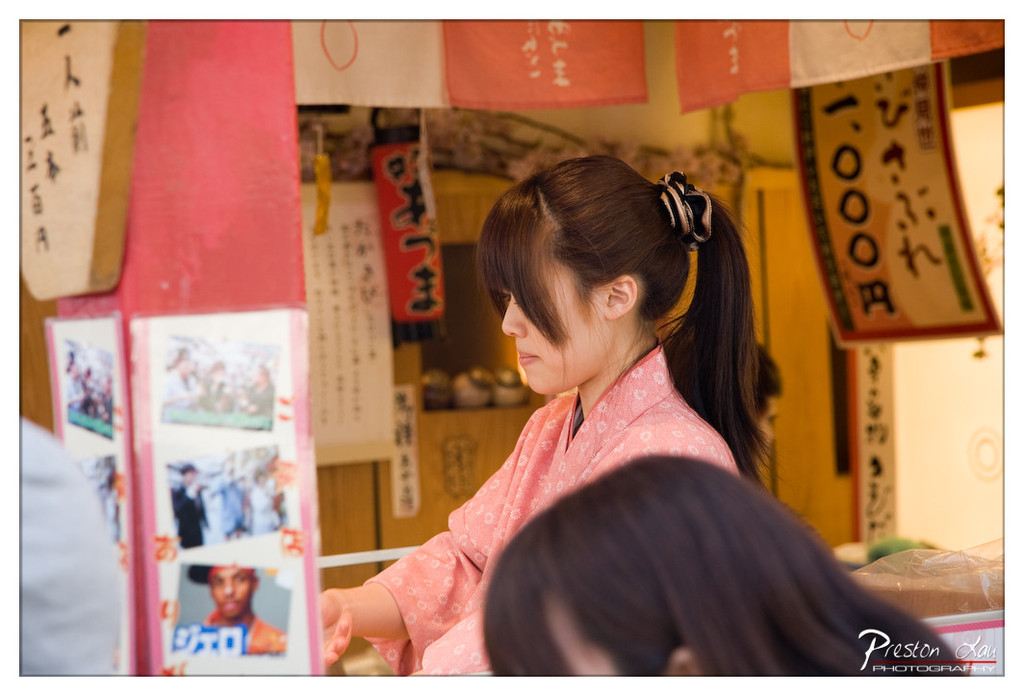

1. Overall Rating (0–10) — 7.0
This photograph captures a quiet, introspective moment within a traditional Japanese setting, where cultural attire and ambient signage evoke a sense of authenticity. The subject’s poised profile and the soft, warm lighting lend the image a contemplative mood, though the foreground obstruction slightly disrupts the narrative flow. While the scene is rich in context, it feels more like a candid glimpse than a fully composed portrait—its charm lies in its sincerity and subtle storytelling.
2. Composition (0–10) — 6.5
The subject is well-placed in profile, creating a natural focal point, but the out-of-focus head in the foreground introduces a visual barrier. A tighter crop or slight shift in angle would improve clarity and engagement.
3. Lighting (0–10) — 7.5
Warm, directional light from the right enhances the depth and texture of the scene, casting a soft glow on the subject’s face and kimono. The ambient glow from the background signs adds a layer of atmospheric richness without overpowering the subject.
4. Color & Tone (0–10) — 7.0
The palette is harmonious, with the pink kimono complementing the red and beige tones of the banners and woodwork. The warm color cast enhances the cultural ambiance, though the saturation is restrained, lending a natural, unprocessed feel.
5. Creativity (0–10) — 7.5
The image succeeds in blending cultural authenticity with personal stillness, capturing a moment that feels both intimate and public. The juxtaposition of traditional elements with modern signage adds subtle narrative depth.
6. Technical Quality (0–10) — 8.0
Sharp focus on the subject’s face and hair, with a pleasing bokeh that isolates her from the busy background. The image is clean, well-exposed, and shows strong control over depth of field.
7. Emotional Impact (0–10) — 7.0
The quiet dignity of the subject and the warm setting evoke a sense of calm and reverence. The viewer is invited into a private moment within a public space, creating a subtle emotional connection through cultural context and human presence.
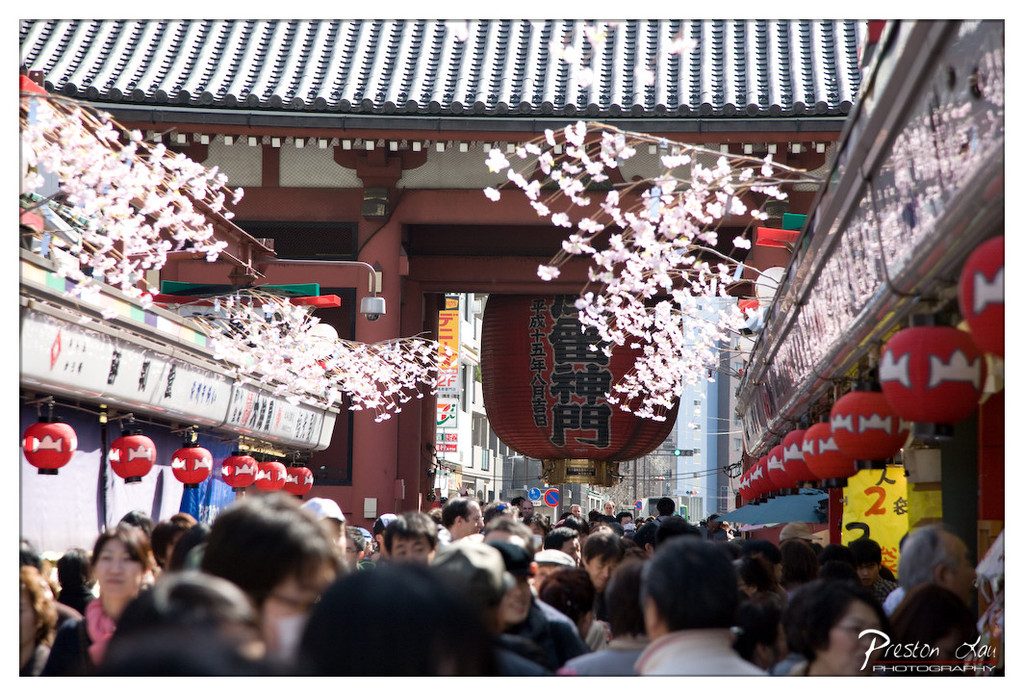

1. Overall Rating (0–10) — 7.5
This photograph captures the vibrant energy of a bustling Japanese street during cherry blossom season, where tradition and modernity collide in a celebration of culture and community. The rich layers of color, movement, and cultural symbols create a dynamic scene that feels both festive and deeply rooted in place. While the composition is dense and the foreground crowd slightly overwhelming, the image succeeds in conveying the sensory intensity of a busy festival day—its charm lies in its authenticity, not in polished perfection.
2. Composition (0–10) — 7.0
The low-angle perspective draws the eye upward through the crowd toward the iconic red lantern and traditional gate, creating a strong focal point. The framing, though crowded, uses the overhead blossoms and lanterns to guide the viewer’s gaze, though the tight space reduces breathing room and slightly diminishes visual clarity.
3. Lighting (0–10) — 7.5
Natural daylight bathes the scene in soft, even light, enhancing the delicate pink hues of the cherry blossoms and the warm tones of the lanterns. The shadows are minimal, preserving detail throughout the frame and contributing to the lively, open-air atmosphere.
4. Color & Tone (0–10) — 8.0
The palette is rich and harmonious, with the soft pinks of the blossoms contrasting beautifully against the deep reds of the lanterns and the muted tones of the tiled roof. The color temperature feels warm and inviting, evoking the gentle glow of springtime in Japan.
5. Creativity (0–10) — 7.5
The photographer captures a moment rich with cultural symbolism—cherry blossoms, lanterns, and a packed street—transforming a busy scene into a narrative of celebration. The use of depth and layered elements adds visual interest, though the image leans more on documentation than conceptual innovation.
6. Technical Quality (0–10) — 8.0
Sharp focus is maintained across the mid-ground, with the lantern and gate clearly defined. The camera’s ability to capture fine detail in both the foreground and background, despite the complexity of the scene, reflects strong technical execution.
7. Emotional Impact (0–10) — 8.0
The image radiates joy and communal energy, evoking a sense of being immersed in a lively festival. The viewer is drawn into the experience, almost able to hear the chatter and footsteps, making the emotional resonance of the scene both immediate and powerful.
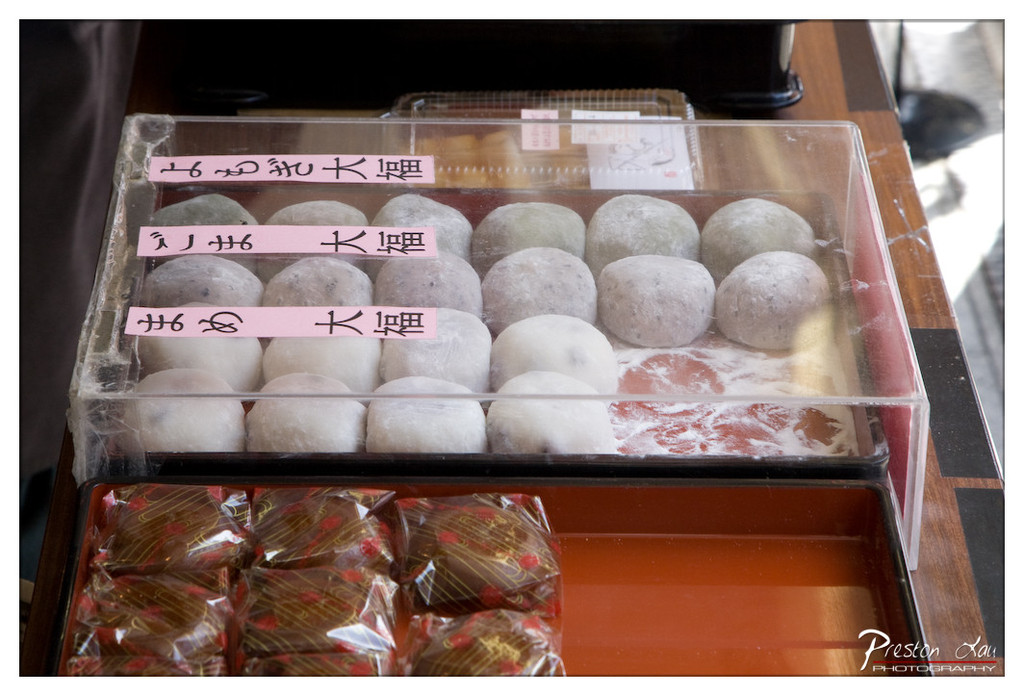

1. Overall Rating (0–10) — 6.0
This photograph captures a traditional Japanese confectionery display with a sense of authenticity and cultural warmth. The arrangement of mochi and wrapped sweets evokes a quiet, artisanal charm, and the handwritten labels add a personal touch. While the image is visually engaging and rich in cultural detail, the composition feels slightly cluttered, and the lighting lacks the subtlety needed to elevate the scene into something more artistically resonant.
2. Composition (0–10) — 5.5
The framing includes both the mochi display and the lower tray, but the depth of field and overlapping elements create visual busyness. A tighter crop would emphasize the mochi and improve focus on the main subject.
3. Lighting (0–10) — 5.0
The light is flat and functional, likely from overhead fluorescent sources, which washes out subtle textures and fails to highlight the soft, powdery surface of the mochi.
4. Color & Tone (0–10) — 6.0
The palette is muted, dominated by whites and grays, with the red of the tray and packaging providing a modest contrast. The tones feel natural but lack vibrancy, reducing the image's visual punch.
5. Creativity (0–10) — 6.5
The choice to include both the raw mochi and the packaged sweets offers a layered narrative about tradition and commerce. The handwritten labels add a personal, artisanal quality that sets the image apart from generic food photography.
6. Technical Quality (0–10) — 7.5
The image is sharp and well-focused, particularly on the mochi and labels. The clarity of the text and textures is strong, and there are no visible technical flaws.
7. Emotional Impact (0–10) — 5.5
The image conveys a sense of calm and tradition, but the lack of dramatic lighting and compositional tension keeps the emotional connection subtle and restrained. It invites appreciation rather than evoking a deeper response.
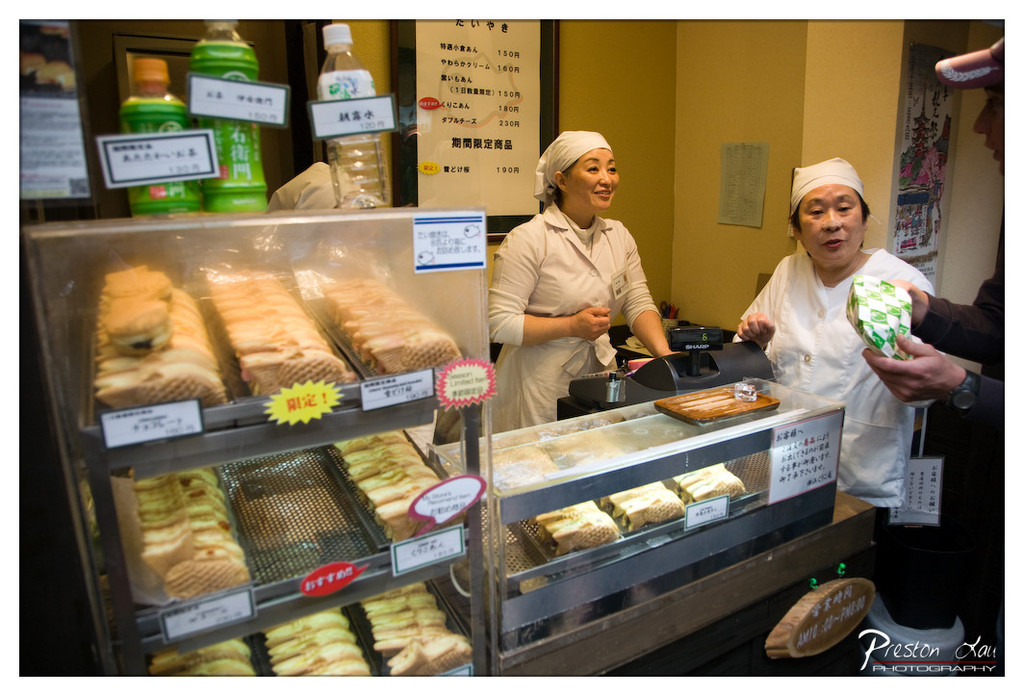

1. Overall Rating (0–10) — 7.0
This photograph captures the lively, authentic atmosphere of a traditional Japanese bakery, where the warmth of human interaction meets the inviting display of fresh pastries. The candid moment between the staff and customer conveys a sense of everyday joy and cultural charm, while the cluttered but purposeful arrangement of signage and products grounds the scene in realism. While the image is rich in narrative, its technical execution and composition slightly hinder its visual impact, preventing it from achieving a more polished, gallery-ready feel.
2. Composition (0–10) — 6.0
The frame is crowded with elements—shelves, signs, and people—creating a sense of depth but also visual noise. The central focus on the two staff members is strong, but the diagonal lines of the display cases and the off-center customer distract from a more balanced composition.
3. Lighting (0–10) — 6.5
The lighting is functional and warm, likely from overhead fluorescent sources, which enhances the cozy, indoor setting. However, it creates harsh reflections on the glass cases and results in uneven exposure, with some areas slightly overexposed and others shadowed.
4. Color & Tone (0–10) — 6.0
The palette is dominated by warm yellows and soft whites, evoking a comforting, homely atmosphere. While the pastries’ golden tones are appealing, the overall color balance is slightly flat, and the lack of vibrant contrast diminishes the image’s visual punch.
5. Creativity (0–10) — 7.0
The photograph succeeds in capturing a genuine, unposed moment that tells a story of daily life in a Japanese bakery. The inclusion of Japanese signage and traditional attire adds cultural authenticity, making the image feel both documentary and personal.
6. Technical Quality (0–10) — 7.0
The focus is sharp on the central figures and the pastries, and the image is free from major technical flaws. However, the depth of field is limited, with some background elements slightly soft, and the reflections on the glass cases introduce minor distractions.
7. Emotional Impact (0–10) — 7.5
The genuine smiles and engaged expressions of the staff create a sense of warmth and connection, inviting the viewer into a moment of simple human kindness. The scene resonates emotionally, evoking nostalgia and a sense of belonging, even for those unfamiliar with the setting.
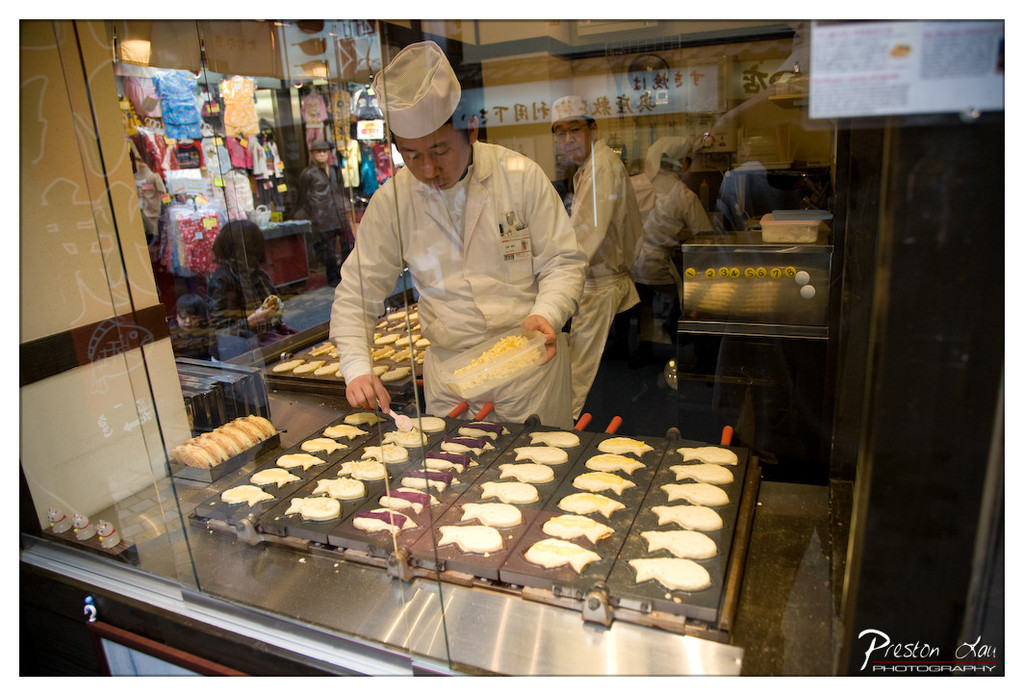

1. Overall Rating (0–10) — 7.5
This photograph captures the lively rhythm of a Japanese fish-shaped pancake (taiyaki) vendor at work, with a compelling blend of action, texture, and cultural authenticity. The glass reflection adds layers to the scene, merging the interior of the kitchen with the bustling street outside. While the composition is slightly cluttered, the candid energy and focus on the artisan at work elevate it beyond mere documentation into a vivid slice of urban life.
2. Composition (0–10) — 7.0
The frame centers on the vendor and his griddle, creating a strong focal point, though the reflections and background elements compete for attention. The diagonal lines of the griddle and the arrangement of the taiyaki add visual interest, but the cluttered foreground and background slightly disrupt the clarity of the narrative.
3. Lighting (0–10) — 6.5
The indoor lighting is functional and even, illuminating the food and the vendor clearly. However, the fluorescent glow lacks warmth, resulting in a somewhat sterile atmosphere. The reflections on the glass also scatter light, adding complexity but reducing the overall luminous quality.
4. Color & Tone (0–10) — 7.0
The palette is grounded in neutral whites and grays, punctuated by the warm beige of the batter and the soft purple of the filling. The contrast between the pale batter and the dark griddle enhances visual clarity, while the subtle pops of color in the background add depth without overwhelming the scene.
5. Creativity (0–10) — 7.5
The image succeeds in capturing a unique cultural moment with a sense of authenticity and motion. The inclusion of reflections adds a layer of narrative complexity, transforming a simple food preparation scene into a dynamic urban tableau. The choice to photograph through glass is both a technical challenge and a creative strength.
6. Technical Quality (0–10) — 8.0
The image is sharp and well-focused, particularly on the vendor and the taiyaki. The depth of field isolates the subject effectively, and the details of the batter and griddle are clearly rendered. The watermark is discreet and unobtrusive.
7. Emotional Impact (0–10) — 7.0
The photograph evokes a sense of warmth and tradition, inviting the viewer into a moment of quiet craftsmanship. The vendor’s concentration and the familiar sight of taiyaki being made stir feelings of nostalgia and appreciation for everyday artistry, though the reflective glass creates a subtle barrier to deeper emotional connection.
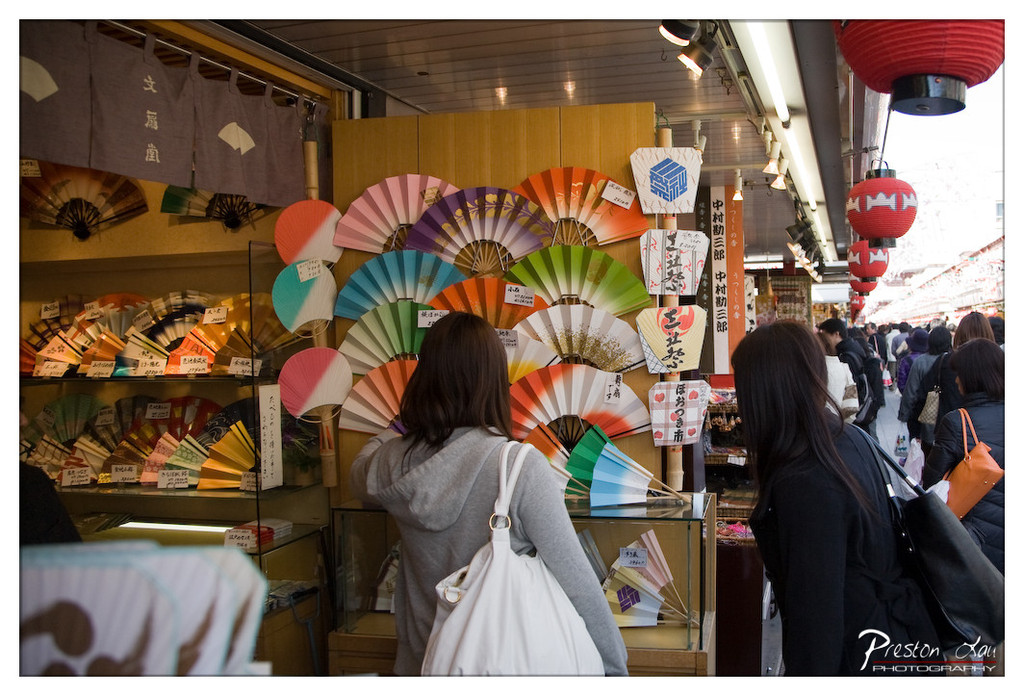

1. Overall Rating (0–10) — 7.0
This photograph captures the lively energy of a traditional Japanese market, where vibrant folding fans and red lanterns create a rich cultural tapestry. The composition draws the viewer into the scene with a sense of movement and discovery, though the crowded environment slightly dilutes the focus. The warm lighting and colorful details evoke a nostalgic, almost cinematic quality, making the image feel both authentic and inviting.
2. Composition (0–10) — 7.0
The framing balances foreground activity with background depth, using the fans and shoppers to create layers. The central placement of the fans draws the eye, while the overhanging lanterns and signage add vertical rhythm. A slightly tighter crop could enhance focus on the main subject.
3. Lighting (0–10) — 6.5
Natural light filters through the covered walkway, creating a soft, diffused glow that enhances the colors of the fans. The overhead fluorescent fixtures add a subtle artificial contrast, but the overall lighting remains even and warm, supporting the scene’s inviting atmosphere.
4. Color & Tone (0–10) — 8.0
The palette is rich and varied, with the rainbow of fans providing a dynamic contrast against the neutral wood and fabric tones. The deep red of the lanterns serves as a strong focal point, while the muted grays and blacks of the shoppers’ clothing ground the composition. The color harmony is strong, evoking a sense of cultural vibrancy.
5. Creativity (0–10) — 7.5
The image successfully blends documentary realism with artistic storytelling, capturing a moment of everyday life with a sense of cultural richness. The choice to include both the merchandise and the people creates a narrative of place and tradition, elevating the scene beyond a simple souvenir snapshot.
6. Technical Quality (0–10) — 7.5
The image is sharp and well-focused, with clear details in the fans and signage. The depth of field is appropriate, keeping the main subject in focus while softly blurring the background. The lighting is well-managed, with no harsh shadows or overexposed highlights.
7. Emotional Impact (0–10) — 7.0
The photograph conveys a sense of warmth, curiosity, and cultural connection. The presence of people browsing the goods invites the viewer to imagine themselves in the moment, evoking feelings of wanderlust and appreciation for tradition. The scene feels alive and authentic, creating a subtle emotional pull.
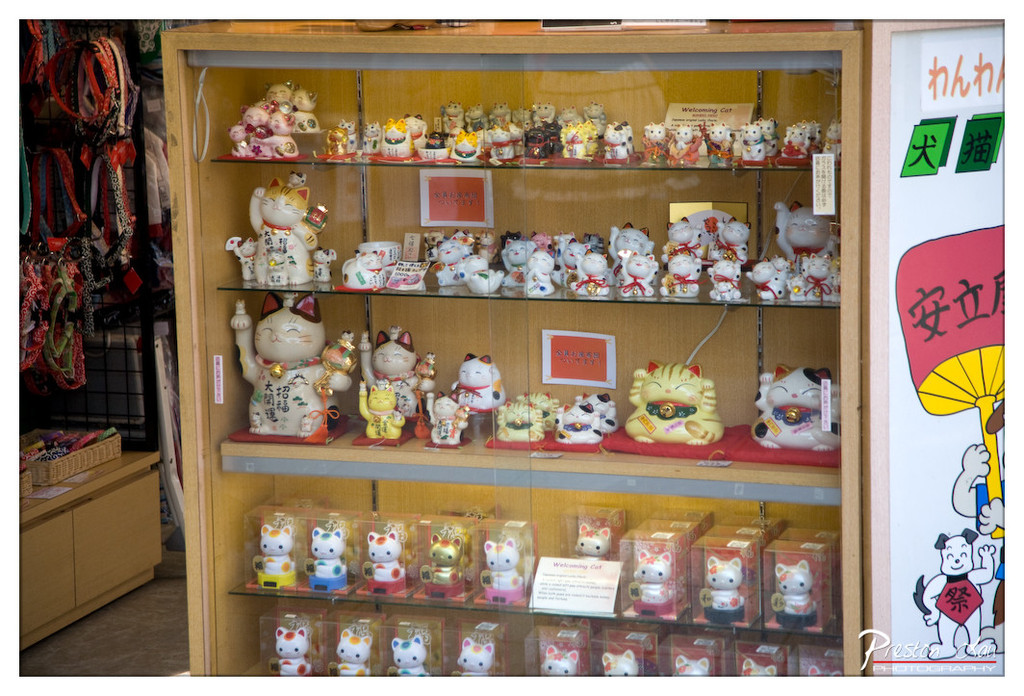

1. Overall Rating (0–10) — 7.0
This photograph captures the vibrant and whimsical atmosphere of a Japanese souvenir shop, where rows of Maneki-neko figurines create a playful, culturally rich display. The warm wooden case and varied expressions of the beckoning cats evoke a sense of charm and tradition, though the cluttered arrangement and busy background slightly distract from the central focus. The image succeeds as a visual narrative of cultural commerce, balancing authenticity with aesthetic appeal.
2. Composition (0–10) — 6.0
The subject is centered but framed too wide, including distracting elements like the hanging accessories and signage on the left. A tighter crop would emphasize the display and improve visual harmony.
3. Lighting (0–10) — 6.5
Natural light filters in from the side, casting soft highlights on the ceramic figures and creating gentle shadows. The lighting is functional and even, though it lacks dramatic contrast, giving the scene a flat, commercial feel.
4. Color & Tone (0–10) — 7.0
The palette is warm and inviting, dominated by the creamy whites and pastel hues of the figurines, accented by pops of red, yellow, and gold. The tone is consistent and cohesive, enhancing the cheerful, festive mood.
5. Creativity (0–10) — 6.5
While the subject matter is inherently charming and culturally specific, the execution remains largely observational. The image documents rather than interprets, with little attempt to elevate the ordinary into something artistically compelling.
6. Technical Quality (0–10) — 7.5
The image is sharp and well-focused, with clear detail visible in the figurines and text. The glass reflections are minimal, and exposure is balanced, indicating solid technical control.
7. Emotional Impact (0–10) — 6.0
The photograph evokes a sense of curiosity and delight, particularly for viewers familiar with Japanese culture. However, the lack of a strong narrative or emotional hook keeps the connection with the viewer at a surface level.
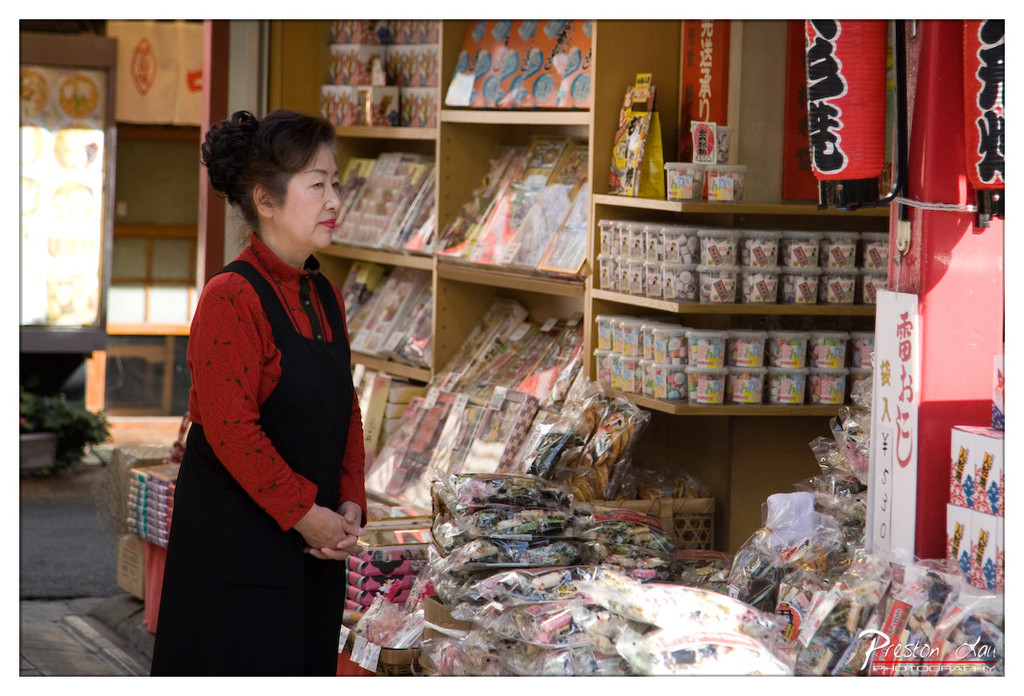

1. Overall Rating (0–10) — 7.0
This photograph captures a quiet moment in a traditional Japanese shop, where the woman’s contemplative stance and the surrounding array of goods evoke a sense of cultural authenticity and everyday dignity. The warm lighting and soft focus lend a nostalgic quality, while the cluttered shelves tell a story of commerce and tradition. While the image is rich in context, it lacks a strong focal point, slightly diminishing its visual impact.
2. Composition (0–10) — 6.5
The subject is placed off-center, creating a natural balance with the shelves and products to the right, but the busy background slightly distracts from her presence. A tighter crop could improve focus and narrative clarity.
3. Lighting (0–10) — 7.0
Soft, directional sunlight enhances the warmth of the scene, casting gentle shadows that add depth and texture. The contrast between the lit subject and shaded background gives the image a natural, candid feel.
4. Color & Tone (0–10) — 7.0
The red of the woman’s shirt creates a vibrant focal point against the earthy browns and muted tones of the shop. The color palette feels authentic and harmonious, with a slightly warm tone that enhances the nostalgic mood.
5. Creativity (0–10) — 6.5
The photograph succeeds in capturing a slice of daily life with sincerity, but its strength lies in documentation rather than artistic interpretation. The composition and framing are observational, not particularly inventive.
6. Technical Quality (0–10) — 7.5
The image is sharp and clear, with good focus on the woman and sufficient detail in the surrounding products. The exposure is well-managed, preserving detail in both highlights and shadows.
7. Emotional Impact (0–10) — 6.5
The quiet introspection of the woman, combined with the familiar setting, invites a sense of empathy and connection to a lived moment. While not emotionally overwhelming, it resonates with a subtle, reflective charm.
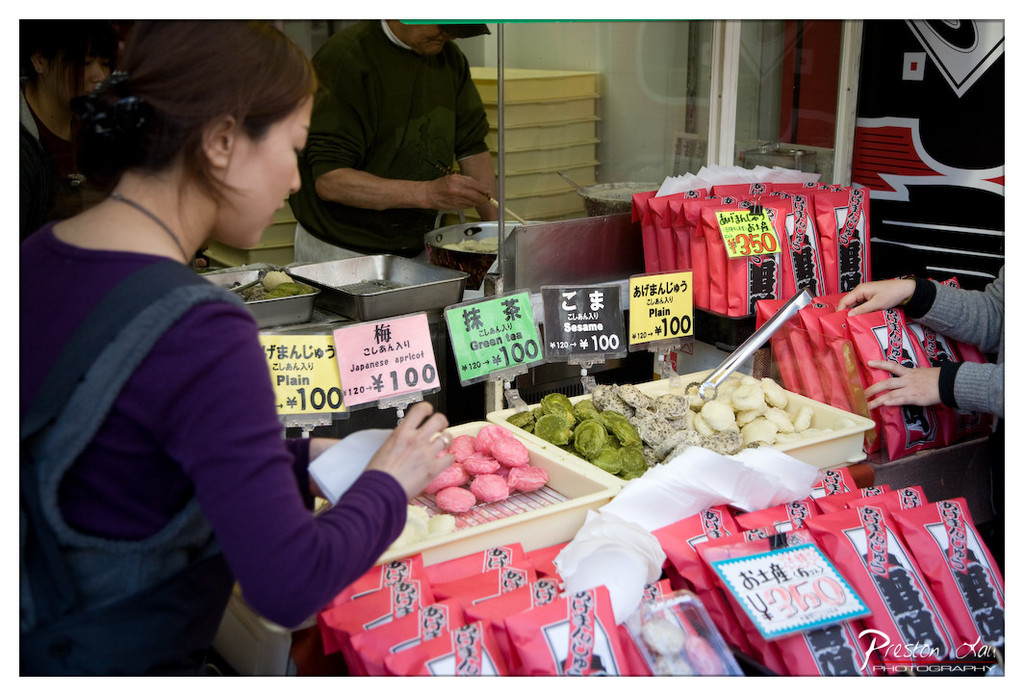

1. Overall Rating (0–10) — 6.8
This photograph captures the vibrant energy of a Japanese street food stall, where tradition meets daily commerce in a lively, authentic setting. The composition is rich with detail—colorful mochi, price tags in both Japanese and English, and the quiet focus of vendors and customers—creating a sense of cultural immersion. While the image is visually engaging, the slight clutter and flat lighting prevent it from achieving a more refined aesthetic, leaving it as a strong documentary snapshot rather than a polished artistic statement.
2. Composition (0–10) — 6.5
The framing is dynamic, capturing both the customer and vendor in a candid moment, but the foreground elements slightly overwhelm the central subject. The diagonal arrangement of the mochi trays and signage guides the eye, though the left-side cut-off of the woman’s head disrupts balance.
3. Lighting (0–10) — 5.5
The light is flat and functional, likely from overhead fluorescent sources, which flattens the scene and diminishes depth. While it clearly illuminates the products and signage, it lacks the warmth or directionality that would enhance mood or texture.
4. Color & Tone (0–10) — 7.0
The palette is lively and intentional, with the bold red packaging and vibrant green and pink mochi creating a strong visual contrast. The color temperature is neutral, which suits the documentary tone, though the saturation could be slightly more pronounced to make the scene pop.
5. Creativity (0–10) — 7.0
The image succeeds in storytelling by capturing a slice of everyday life in Japan with authenticity and cultural specificity. The inclusion of bilingual signage and the variety of mochi types adds narrative depth, suggesting a blend of local tradition and tourist appeal.
6. Technical Quality (0–10) — 7.5
The focus is sharp across the mid-ground, allowing clear visibility of the mochi, signs, and hands. The resolution is high, and the details in the packaging and textures are well preserved. The watermark is discreet and does not distract.
7. Emotional Impact (0–10) — 6.5
The image evokes a sense of curiosity and warmth, inviting the viewer into a bustling marketplace. While the emotional resonance is present, it remains grounded in observation rather than evoking a deeper personal connection or nostalgia.
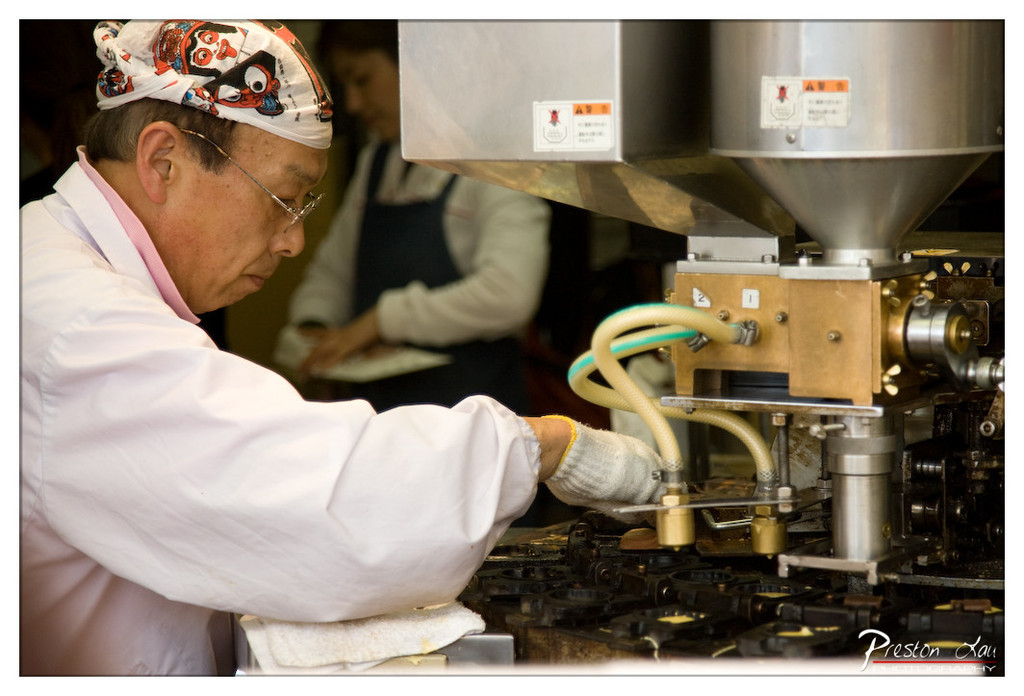

1. Overall Rating (0–10) — 7.5
This photograph captures the focused intensity of a craftsman at work, blending tradition with industrial precision in a dynamic kitchen setting. The subject’s concentration and the intricate machinery create a compelling narrative of skill and dedication. While the composition is strong and the moment feels authentic, a more deliberate use of depth of field might further isolate the subject and enhance the emotional pull.
2. Composition (0–10) — 7.0
The subject is well-placed on the left, leading the eye toward the machinery, but the background figure slightly distracts from the main focus. The diagonal lines of the machine and hoses add energy, though the cluttered foreground and midground reduce clarity.
3. Lighting (0–10) — 6.5
The lighting is functional and even, likely from overhead fluorescent sources, which highlights the subject’s face and hands without creating dramatic shadows. While clear and informative, the light lacks warmth and depth, giving the scene a slightly clinical feel.
4. Color & Tone (0–10) — 6.0
The palette is dominated by whites, grays, and metallic tones, with the colorful bandana providing a subtle focal point. The lack of rich contrast or vibrancy tempers the image’s visual impact, though the tonal balance supports the industrial atmosphere.
5. Creativity (0–10) — 7.0
The juxtaposition of traditional attire with modern machinery offers a compelling cultural and industrial narrative. The photographer captures a moment that feels both documentary and artistic, though the approach leans more toward observation than bold reinterpretation.
6. Technical Quality (0–10) — 8.0
Sharp focus on the subject’s face and hands, with adequate depth of field to keep the machinery in view. The image is well-exposed and free of technical flaws, though slight noise in the shadows suggests a higher ISO was used.
7. Emotional Impact (0–10) — 7.0
There’s a quiet dignity in the worker’s focus, evoking respect for craftsmanship and routine. The viewer is drawn into the rhythm of the process, feeling a connection to the labor and tradition behind the scene, though the emotional resonance is held back by the impersonal lighting and environment.
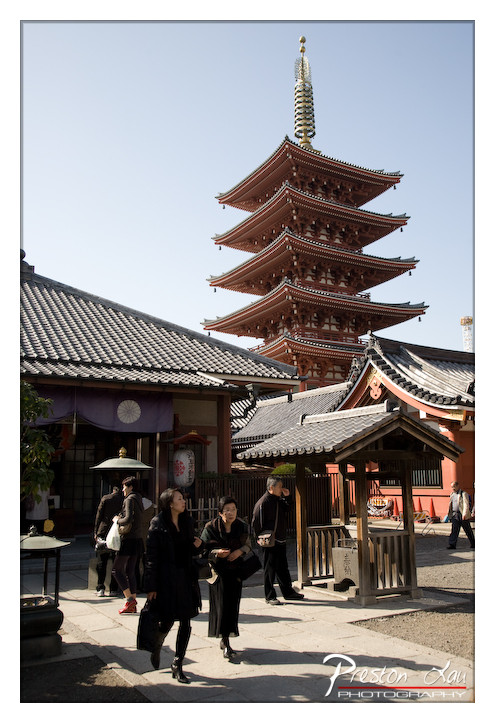

1. Overall Rating (0–10) — 7.5
This photograph captures the serene grandeur of a traditional Japanese temple complex, where ancient architecture meets the quiet rhythm of daily life. The five-tiered pagoda rises with elegant symmetry against a clear blue sky, while visitors stroll through the courtyard, grounding the scene in human scale and movement. While the composition is strong and the subject compelling, the slightly flat lighting and muted color palette temper its emotional resonance, holding it just short of transcendent.
2. Composition (0–10) — 8.0
The pagoda dominates the frame with vertical strength, balanced by the horizontal lines of the surrounding buildings and the walkway. The placement of people in the foreground adds depth and narrative, guiding the eye toward the temple’s spiritual centerpiece.
3. Lighting (0–10) — 7.0
Bright, natural daylight illuminates the scene evenly, enhancing the architectural details without creating harsh shadows. The soft contrast suggests a midday sun, lending clarity and a sense of openness to the image.
4. Color & Tone (0–10) — 7.0
The palette is restrained—earth tones of wood and tile contrast with the vibrant red of the pagoda and the deep blue of the sky. While harmonious, the tones lack vibrancy, giving the image a slightly subdued quality.
5. Creativity (0–10) — 7.5
The photograph successfully blends cultural documentation with aesthetic composition, capturing both the sacred and the everyday. The interplay of tradition and movement offers a narrative depth that feels both respectful and engaging.
6. Technical Quality (0–10) — 8.0
Sharp focus and clean detail are evident throughout, particularly in the intricate woodwork of the pagoda and the textures of the tiled roofs. The image is well-exposed and free of noticeable technical flaws.
7. Emotional Impact (0–10) — 7.0
The image evokes a sense of peace and reverence, inviting the viewer into a moment of quiet contemplation. The presence of people adds warmth and connection, making the sacred space feel accessible and alive.
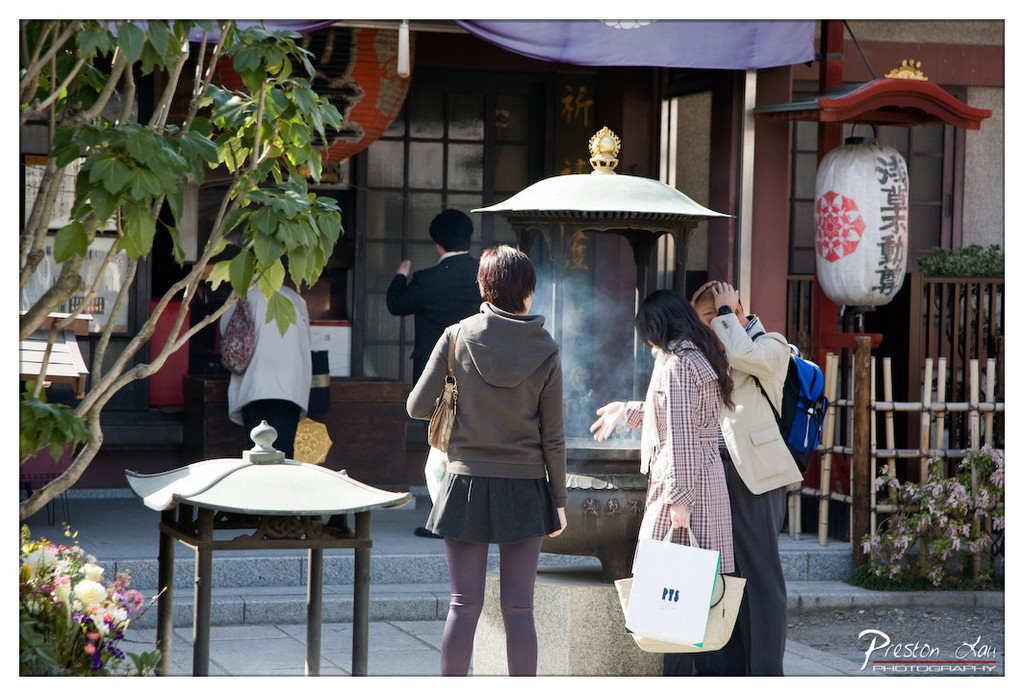

1. Overall Rating (0–10) — 7.0
This photograph captures a quiet, contemplative moment at a Japanese temple, where tradition and modern life intersect. The soft smoke rising from the incense burner and the gentle gestures of the visitors lend a sense of reverence and stillness. While the scene is rich with cultural detail, the composition feels slightly over-crowded, and the lighting, though natural, doesn’t fully elevate the mood into something truly cinematic.
2. Composition (0–10) — 6.5
The framing includes several elements—people, lanterns, foliage, and architectural details—that create visual interest but also introduce some clutter. The central incense burner acts as a focal point, but the off-center placement of the subjects and the tree branch in the foreground slightly disrupts balance.
3. Lighting (0–10) — 7.0
Natural daylight illuminates the scene evenly, with soft shadows that suggest a late morning or early afternoon. The light enhances the textures of the stone, wood, and fabric, and the smoke catches the light beautifully, adding depth and atmosphere.
4. Color & Tone (0–10) — 7.5
The palette is harmonious, with earthy tones of brown and gray complemented by the vibrant purple of the canopy and the soft pinks and greens of the flowers. The contrast between the traditional red lantern and the modern backpacks adds visual interest and underscores the blend of old and new.
5. Creativity (0–10) — 7.0
The image captures a candid cultural moment with authenticity, and the photographer’s choice to include both the ritual and the contemporary visitors adds narrative depth. The use of smoke and layered elements creates a sense of movement and atmosphere.
6. Technical Quality (0–10) — 8.0
The image is sharp, with clear focus on the central figures and incense burner. The depth of field is well-managed, keeping key elements in focus while softly blurring the background. The exposure is balanced, and the camera’s dynamic range handles the bright and shaded areas effectively.
7. Emotional Impact (0–10) — 7.0
There’s a quiet dignity in the scene—visitors engaged in a familiar ritual, the smoke curling into the air like a prayer. The viewer is drawn into the moment, not as an observer, but as a witness to a shared human experience of reflection and tradition.
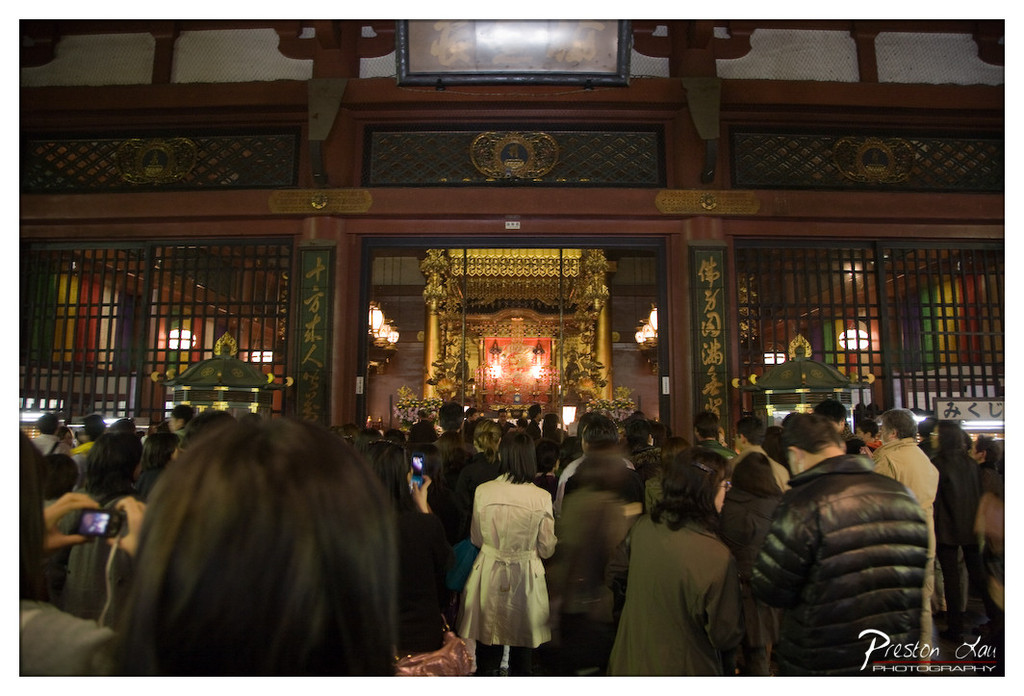

1. Overall Rating (0–10) — 7.0
This photograph captures the vibrant energy of a crowded temple during a sacred or festive occasion, with the ornate shrine glowing at the heart of the scene. The composition draws the viewer into the crowd, evoking a sense of participation and reverence, though the lack of sharp focus on individuals tempers the emotional clarity. The contrast between the warm, radiant shrine and the dim, shadowed gathering creates a compelling visual narrative of devotion and tradition.
2. Composition (0–10) — 7.5
The framing centers the golden shrine as a focal point, with the crowd forming a natural leading path toward it. The over-the-shoulder perspective immerses the viewer, though the density of figures creates slight visual clutter that slightly disrupts the balance.
3. Lighting (0–10) — 7.0
The warm, directional lighting from the shrine casts a golden glow that illuminates the scene, contrasting with the darker surroundings. The ambient light enhances the spiritual atmosphere, while the flash on the crowd introduces subtle harshness, slightly flattening details.
4. Color & Tone (0–10) — 7.5
The rich, saturated golds of the shrine stand out against the muted, cool tones of the crowd and architecture. The color palette effectively conveys warmth and reverence, with a natural tonal range that enhances the scene’s authenticity.
5. Creativity (0–10) — 7.0
The photograph captures a moment of cultural and spiritual significance with strong narrative intent. The choice to shoot from within the crowd adds intimacy, though the composition leans toward documentary rather than stylized interpretation.
6. Technical Quality (0–10) — 7.0
The image is sharp enough to convey detail in the shrine and architectural elements, but some motion blur and noise in the lower-light areas affect clarity. Focus is centered on the shrine, which is appropriate, though the foreground figures are less defined.
7. Emotional Impact (0–10) — 7.5
The image conveys a deep sense of communal reverence and devotion, drawing the viewer into a shared spiritual experience. The warmth of the shrine and the presence of people gathered in quiet focus evoke a feeling of unity and tradition.
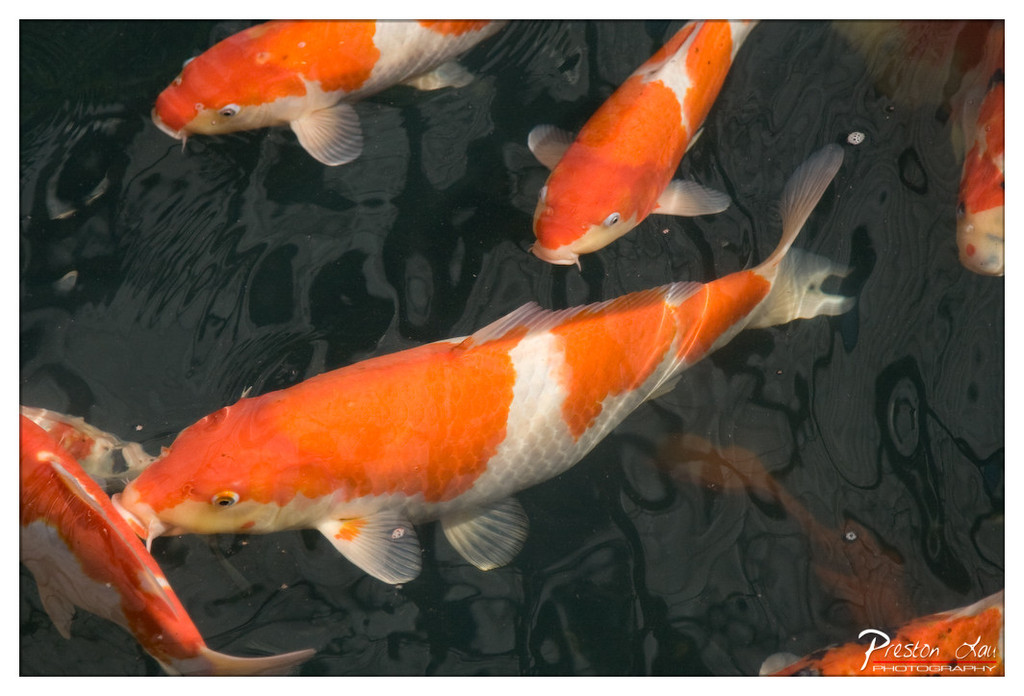

1. Overall Rating (0–10) — 7.5
This photograph captures the serene elegance of koi fish gliding through dark, rippling water, evoking a sense of calm and natural grace. The vibrant orange and white patterns of the fish contrast beautifully against the deep, reflective surface, creating a visually harmonious composition. While the image succeeds in conveying tranquility and movement, a more deliberate framing and lighting control could elevate its artistic impact.
2. Composition (0–10) — 7.0
The diagonal arrangement of the koi creates a sense of motion, guiding the eye across the frame. However, the scattered placement of the fish and the inclusion of partial bodies at the edges slightly disrupt visual cohesion, making the composition feel more casual than curated.
3. Lighting (0–10) — 7.5
The lighting highlights the texture and color of the koi’s scales, with soft reflections on the water surface enhancing depth. The contrast between the brightly lit fish and the dark water is effective, though some areas of the background remain overly shadowed, losing detail.
4. Color & Tone (0–10) — 8.0
The rich, warm orange tones of the koi stand out vividly against the cool, dark tones of the water, creating a striking and balanced palette. The subtle variations in hue and saturation add depth and realism, contributing to the image’s natural beauty.
5. Creativity (0–10) — 7.5
The image captures a moment of quiet life with an almost meditative quality, suggesting a deep connection between the subject and its environment. The photographer’s choice to emphasize the fish’s movement and color pattern offers a fresh perspective on a familiar subject.
6. Technical Quality (0–10) — 8.0
The focus is sharp on the central koi, with clear detail in the scales and fins. The depth of field is appropriately managed, keeping the foreground subjects crisp while softly blurring the background. The image is clean and well-exposed, with no noticeable technical flaws.
7. Emotional Impact (0–10) — 8.0
The photograph evokes a sense of peace and contemplation, inviting the viewer to pause and reflect on the gentle rhythm of life. The lifelike portrayal of the koi and the tranquil setting create a strong emotional resonance, making the image both calming and memorable.
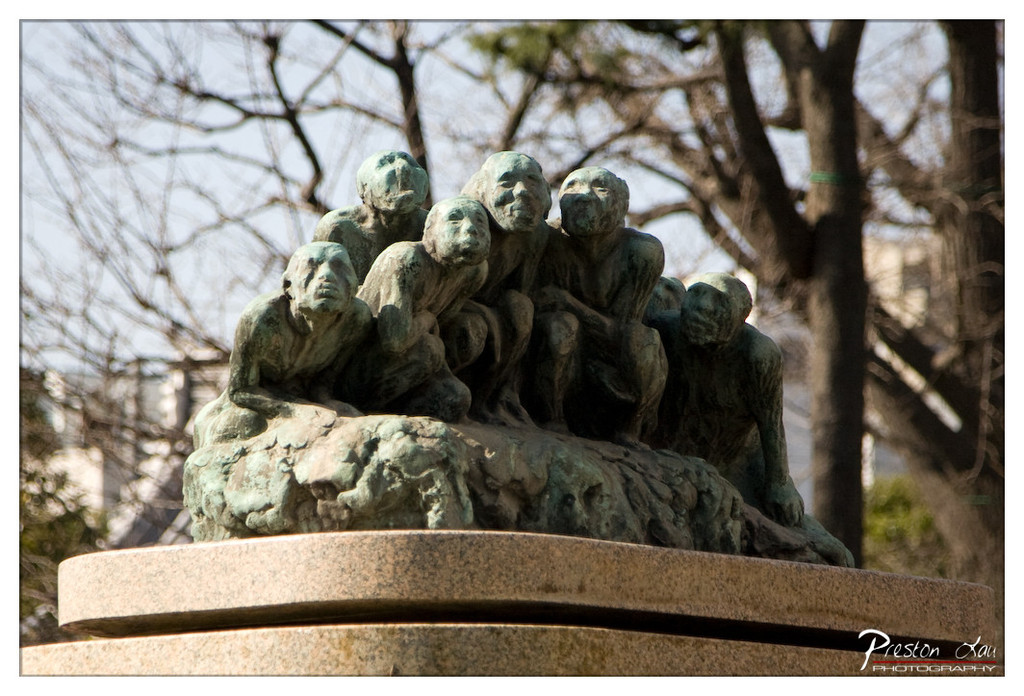

1. Overall Rating (0–10) — 7.5
This photograph captures the haunting gravity of a bronze sculpture depicting a group of emaciated figures, their expressions etched with suffering and resilience. The shallow depth of field isolates the monument from its surroundings, emphasizing its emotional weight and historical resonance. While the image succeeds in conveying the sculpture’s somber tone, the slightly overexposed sky and lack of dynamic contrast temper its overall visual impact.
2. Composition (0–10) — 7.0
The subject is well-framed, centered to draw focus to the figures, though the composition feels slightly static. The diagonal base of the pedestal adds subtle visual interest, but the background foliage and bare branches create a busy, distracting backdrop that competes with the sculpture’s emotional narrative.
3. Lighting (0–10) — 6.5
Natural daylight illuminates the sculpture with soft, even light, highlighting texture and form. However, the overexposed sky creates a loss of detail in the upper portion of the frame, and the flat lighting lacks the dramatic shadows that might deepen the sculpture’s emotional weight.
4. Color & Tone (0–10) — 6.0
The green patina of the bronze contrasts with the muted beige of the stone base, but the overall palette is restrained and somewhat desaturated. The cool tones of the sculpture are offset by the warm stone, but the lack of vibrancy limits the image’s visual richness.
5. Creativity (0–10) — 7.5
The photographer’s choice to use a shallow depth of field effectively isolates the sculpture, creating a sense of reverence and focus. The decision to capture the work in natural light enhances its authenticity, lending the image a documentary-like quality that underscores the monument’s solemn purpose.
6. Technical Quality (0–10) — 7.5
Sharp focus on the sculpture ensures clarity and detail, while the smooth bokeh in the background demonstrates strong lens control. The exposure is generally well-managed, though the highlight loss in the sky slightly undermines technical precision.
7. Emotional Impact (0–10) — 8.0
The image evokes a powerful sense of sorrow and remembrance, drawing the viewer into the quiet dignity of the figures. The emotional resonance is amplified by the sculpture’s inherent gravity, making the photograph a poignant tribute to memory and loss.
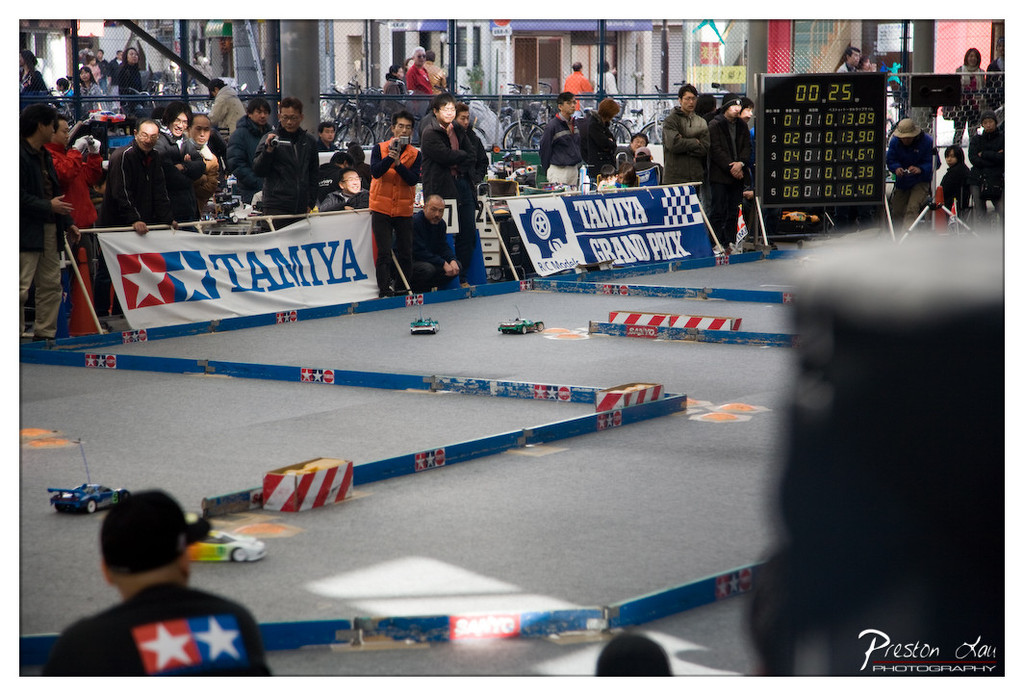

1. Overall Rating (0–10) — 7.0
This photograph captures the vibrant energy of a Tamiya Grand Prix remote-controlled car race, brimming with motion, competition, and spectator engagement. The dynamic composition draws the eye across the track, while the blurred foreground and sharp background create a sense of immediacy and immersion. Though slightly cluttered with overlapping elements, the image successfully conveys the excitement of a live event, with the Tamiya branding and digital scoreboard grounding the scene in authenticity.
2. Composition (0–10) — 7.0
The frame is balanced with the track diagonally slicing through the image, guiding the viewer’s eye toward the action. The foreground blur and background crowd create depth, though the overhang of the person’s head at the bottom right slightly disrupts visual flow.
3. Lighting (0–10) — 6.5
Natural daylight provides even illumination, with soft shadows suggesting an overcast day. The lighting is functional but lacks dramatic contrast, which slightly diminishes the visual punch of the racing cars and signage.
4. Color & Tone (0–10) — 6.0
The dominant blue of the track and banners creates a cohesive color scheme, but the overall tone is somewhat muted. The red and white accents of the barriers add contrast, yet the lack of saturation reduces the image’s vibrancy.
5. Creativity (0–10) — 7.0
The photographer captures a niche hobby event with authenticity and energy, transforming a casual gathering into a visually compelling narrative. The inclusion of the blurred foreground element adds a sense of being present, enhancing the scene’s immersive quality.
6. Technical Quality (0–10) — 7.5
The image is sharp where it counts—on the track and the scoreboard—while the shallow depth of field effectively isolates the action. Focus and exposure are well-managed, though slight noise is visible in the darker areas.
7. Emotional Impact (0–10) — 7.0
The photograph evokes a sense of nostalgia and community, appealing to both hobbyists and general viewers. The crowd’s engagement and the competitive atmosphere create a palpable sense of excitement and shared experience.
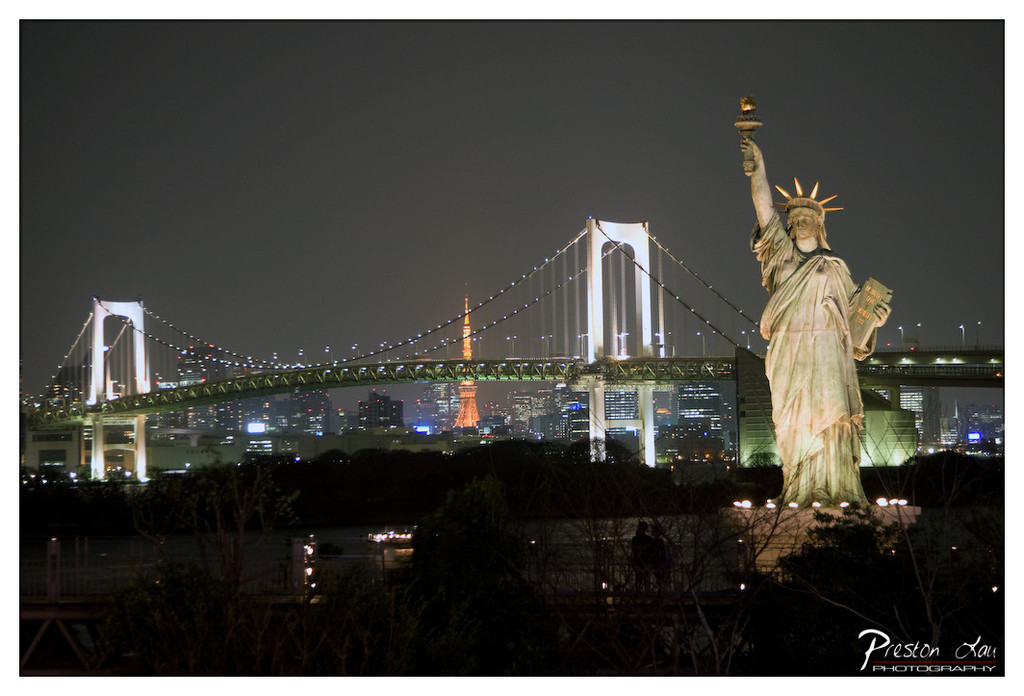

1. Overall Rating (0–10) — 7.0
This nighttime photograph captures a striking juxtaposition of global icons, blending the Statue of Liberty replica with Tokyo’s vibrant skyline and the Rainbow Bridge. The composition balances familiar symbols with a sense of urban energy, creating a visually compelling narrative of cultural fusion. While the image effectively conveys its thematic intent, the lighting and framing occasionally undercut the scene’s potential for dramatic impact.
2. Composition (0–10) — 6.5
The Statue of Liberty dominates the right side, creating a strong focal point, while the Rainbow Bridge and Tokyo Tower anchor the midground. The dark foreground foliage adds depth, though it slightly obscures the lower portion of the frame. The diagonal line of the bridge guides the eye through the scene, but the composition feels slightly unbalanced due to the heavy visual weight on the right.
3. Lighting (0–10) — 7.0
The scene is well-lit by artificial lights, with the illuminated bridge and city skyline creating a dynamic contrast against the dark sky. The statue itself is properly lit, highlighting its form, though the light on its surface appears somewhat flat. The ambient glow of the city adds warmth and atmosphere, enhancing the nocturnal mood.
4. Color & Tone (0–10) — 6.5
The color palette is dominated by cool blues and whites from the city lights and bridge, contrasted with the warm golden glow of the statue and Tokyo Tower. The overall tone is moody and urban, though the colors lack subtle gradation, giving the image a slightly digital or over-processed feel.
5. Creativity (0–10) — 7.5
The concept of placing a replica of the Statue of Liberty in Tokyo is inherently creative and thought-provoking, blending American symbolism with Japanese urban culture. The choice to photograph it at night enhances the surreal quality, making it more than a simple tourist shot—it becomes a commentary on globalization and cultural exchange.
6. Technical Quality (0–10) — 7.5
The image is sharp and clear, with fine detail visible in the bridge and cityscape. The long exposure has rendered the lights smoothly, minimizing motion blur. Focus is well-managed, and the exposure is balanced, though slight noise is present in the darker areas.
7. Emotional Impact (0–10) — 6.5
The photograph evokes a sense of wonder and curiosity, inviting the viewer to reflect on the intersection of identity and place. The juxtaposition of the statue and the city creates a subtle emotional resonance, though the lack of human presence keeps the mood somewhat detached and observational.
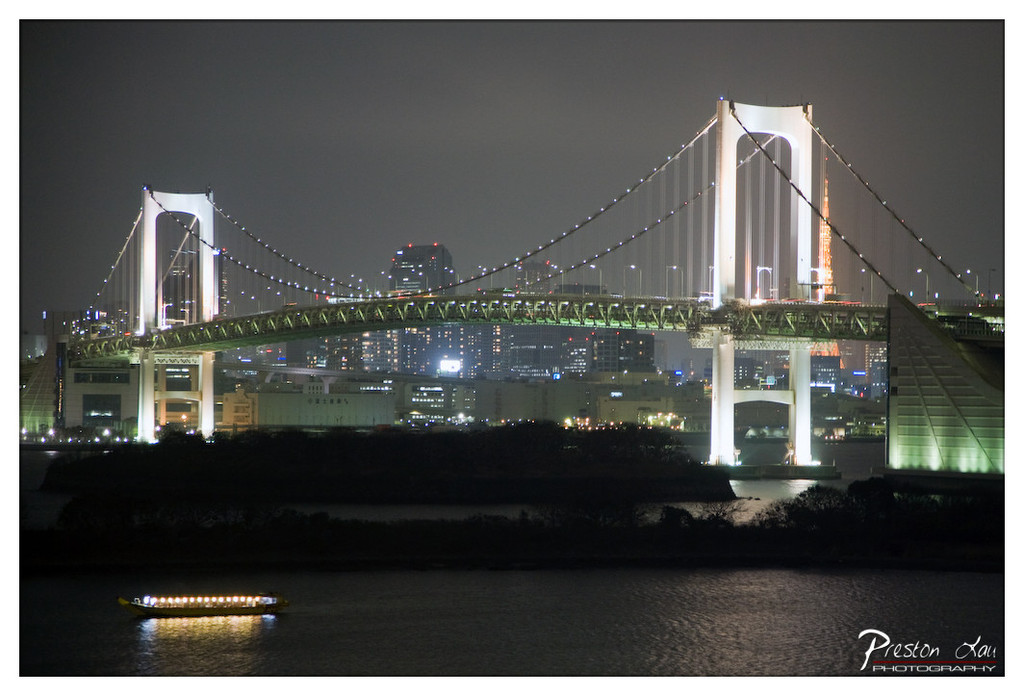

1. Overall Rating (0–10) — 7.0
This nighttime cityscape captures the quiet majesty of Tokyo’s Rainbow Bridge, where artificial light transforms infrastructure into a luminous sculpture against the dark sky. The warm glow of the boat below adds a sense of scale and motion, grounding the grandeur of the bridge in human experience. While the composition is strong and the mood contemplative, the image’s potential is slightly diminished by a lack of dynamic contrast and a muted color palette that softens the scene’s impact.
2. Composition (0–10) — 7.5
The bridge dominates the frame with strong symmetry, anchored by the central arch and flanked by the city skyline. The boat in the lower-left corner provides a subtle focal point and visual balance, guiding the eye across the water. The dark foreground adds depth, though the wide framing slightly dilutes the intensity of the bridge’s presence.
3. Lighting (0–10) — 7.0
The illumination of the bridge is crisp and intentional, highlighting its architectural form with clean white lights. The ambient city glow provides a soft backdrop, but the flat, overcast sky prevents the light from creating strong contrast or dramatic shadows. The boat’s warm lights offer a pleasing counterpoint, enhancing the scene’s nocturnal mood.
4. Color & Tone (0–10) — 6.5
The palette is dominated by cool whites and grays, with subtle hints of green from the bridge’s structure and warm yellow tones from the boat. While the colors are harmonious, the overall tone is somewhat flat and lacks richness, particularly in the sky and water, where the lack of tonal variation reduces visual interest.
5. Creativity (0–10) — 7.0
The photographer captures a familiar urban landmark with a contemplative, almost poetic sensibility. The inclusion of the boat introduces a narrative element—movement, life, and scale—elevating the image beyond a mere architectural snapshot. The choice to shoot at night adds a layer of quiet elegance, though the concept remains grounded in realism rather than bold experimentation.
6. Technical Quality (0–10) — 8.0
The image is sharp and well-exposed, with clear details in the bridge’s structure and city lights. The long exposure technique effectively captures the boat’s light trail and smooth water, indicating strong technical control. The watermark is discreet and unobtrusive, preserving the photo’s integrity.
7. Emotional Impact (0–10) — 7.0
The image evokes a sense of calm and urban serenity, inviting the viewer to pause and reflect on the harmony between human engineering and natural stillness. The quiet beauty of the illuminated bridge against the dark river and sky creates a meditative mood, though the emotional resonance is tempered by the lack of dramatic contrast or vivid color.
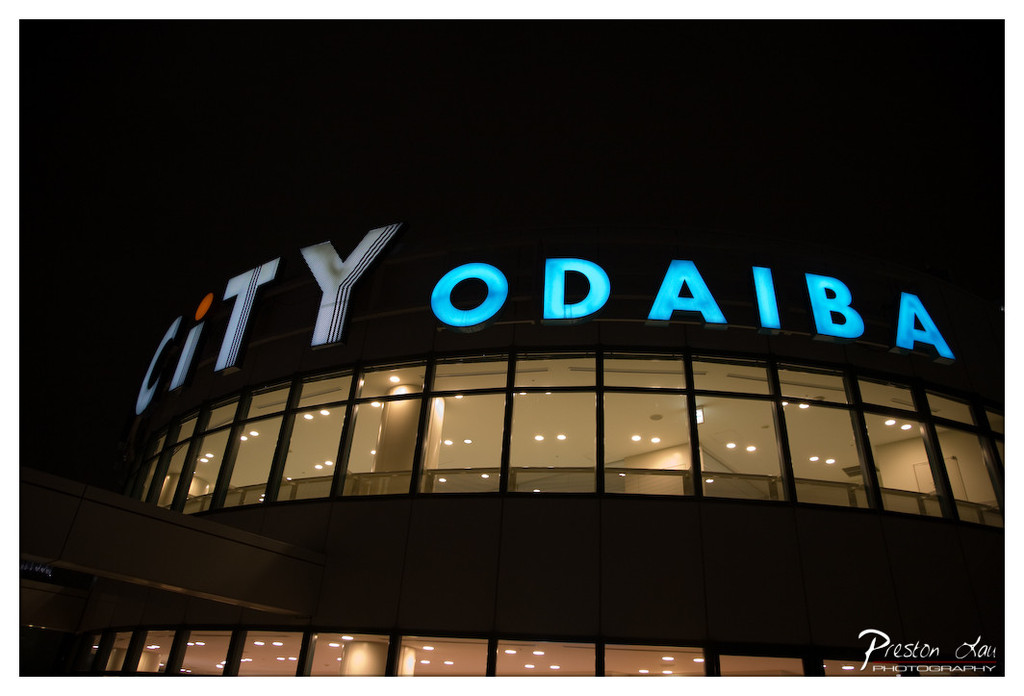

1. Overall Rating (0–10) — 7.0
This photograph captures the quiet majesty of a modern urban landmark at night, where the glowing "CITY ODAIBA" sign becomes a beacon against the darkness. The low-angle perspective emphasizes the building’s scale and the luminous sign’s presence, while the warm interior lights offer a subtle contrast to the cool blue of the signage. While the image is visually striking, its emotional depth is somewhat restrained by the lack of human presence or dynamic context, leaving it as a strong architectural portrait rather than a compelling narrative.
2. Composition (0–10) — 7.5
The low-angle framing enhances the building’s grandeur, and the curved sign draws the eye across the frame. The alignment of the sign with the architectural lines creates a sense of harmony, though the tight crop slightly limits the sense of space.
3. Lighting (0–10) — 8.0
The contrast between the cool blue neon and the warm interior lights creates a balanced and atmospheric nighttime scene. The dark sky enhances the luminosity of the sign, and the exposure captures both the glow and the details within the windows.
4. Color & Tone (0–10) — 7.5
The cool blue of the sign dominates the palette, creating a modern, almost futuristic mood, while the warm yellow tones from the interior lights provide a gentle counterpoint. The tonal range is well-managed, with no loss of detail in the shadows or highlights.
5. Creativity (0–10) — 7.0
The choice to focus on the signage and architecture at night is effective and visually engaging. While not particularly original in concept, the execution emphasizes mood and form, offering a stylish interpretation of urban nightlife.
6. Technical Quality (0–10) — 8.0
The image is sharp and well-focused, with clean details in both the sign and the windows. The long exposure appears controlled, with no visible motion blur or noise, suggesting strong technical execution.
7. Emotional Impact (0–10) — 6.5
The photograph evokes a sense of calm urban solitude, with the illuminated building standing as a silent monument to modernity. The lack of people or activity lends it a contemplative, almost melancholic tone, inviting reflection on the spaces we inhabit.
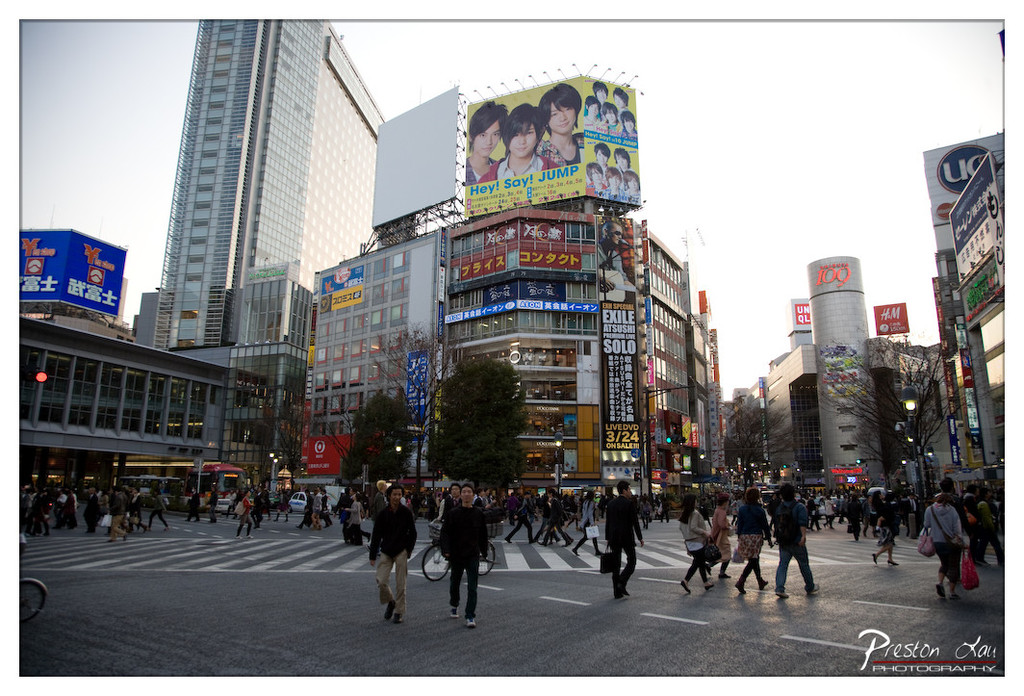

1. Overall Rating (0–10) — 7.0
This photograph captures the vibrant energy of a bustling urban intersection in Tokyo, where the density of people and signage creates a dynamic, almost chaotic rhythm. The wide-angle perspective immerses the viewer in the scene, and the late afternoon light softens the harshness of the city’s commercial glare. While the image successfully conveys the intensity of urban life, the visual clutter slightly undermines its clarity, making it feel more like a snapshot than a curated composition.
2. Composition (0–10) — 6.5
The wide-angle lens emphasizes the scale of the environment, with the crosswalk leading the eye into the frame. However, the multitude of signs and pedestrians creates visual noise, and the lack of a clear focal point disperses attention across the scene.
3. Lighting (0–10) — 6.0
The soft, diffused light of late afternoon adds a gentle glow, reducing harsh shadows and allowing details to emerge across the frame. The sky is slightly overexposed, but the overall lighting enhances the atmosphere without overwhelming the scene.
4. Color & Tone (0–10) — 6.5
The palette is rich with the blues and reds of signage, contrasted against the neutral tones of the buildings and pavement. The colors are vivid but not oversaturated, preserving a sense of realism. The warm glow of the setting sun adds subtle tonal depth.
5. Creativity (0–10) — 7.0
The image captures a quintessential moment of urban life with a sense of authenticity and motion. The inclusion of the large billboard featuring J-pop idols adds cultural specificity, lending narrative depth and a touch of whimsy to the otherwise utilitarian cityscape.
6. Technical Quality (0–10) — 7.5
The image is sharp and well-focused, with clean details throughout the frame. The exposure is balanced, and the wide-angle perspective is handled with control, though slight overexposure in the sky detracts from the overall technical polish.
7. Emotional Impact (0–10) — 6.5
The photograph evokes a sense of movement and connection, capturing the rhythm of daily life in a major metropolis. While the emotional resonance is strong, the sheer volume of information keeps the viewer from forming a deeper personal connection to any single moment.
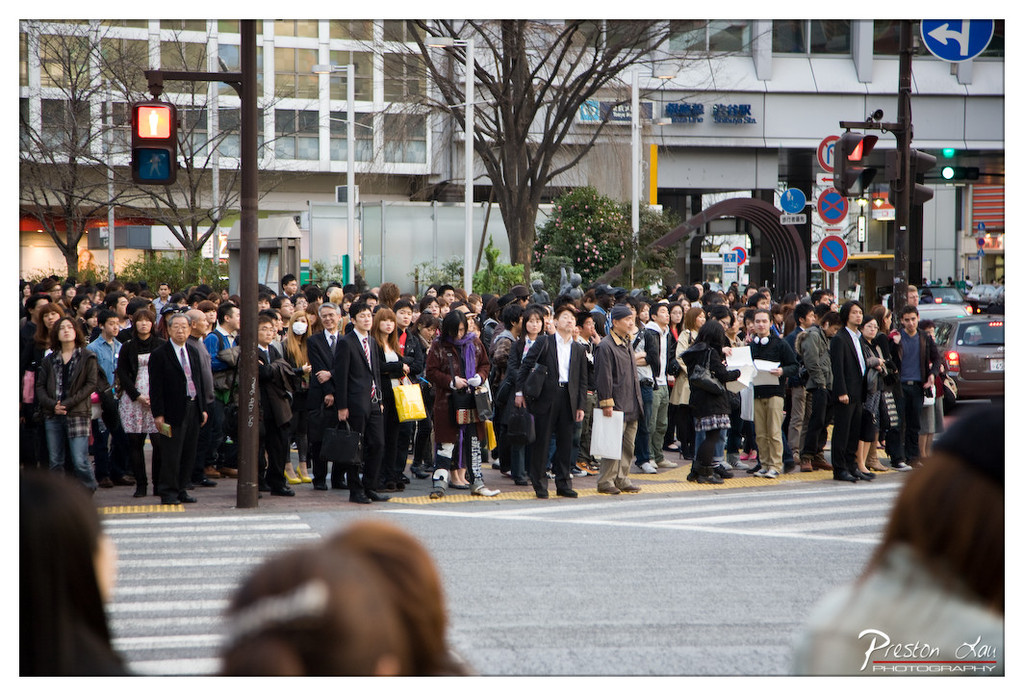

1. Overall Rating (0–10) — 6.8
This photograph captures the quiet tension of a crowded urban intersection, where the stillness of waiting contrasts with the implied motion of a bustling city. The composition, while slightly cluttered, effectively conveys the rhythm of daily life in a densely populated metropolis. The red pedestrian signal and the sea of expectant faces create a sense of collective anticipation, though the image's documentary clarity occasionally undermines its emotional depth.
2. Composition (0–10) — 6.5
The frame is anchored by the crosswalk and the crowd, creating a strong horizontal axis, but the foreground blur and busy background distract from the central subject. A tighter crop would improve focus on the human element.
3. Lighting (0–10) — 6.0
Natural daylight illuminates the scene evenly, but the overcast sky flattens shadows and reduces dimensionality. The red traffic light provides a subtle focal point, yet the overall lighting lacks drama.
4. Color & Tone (0–10) — 6.5
The palette is subdued, dominated by grays and muted earth tones, which reflect the urban environment. The red of the traffic light offers a small but effective accent, while the cool tones enhance the impersonal atmosphere.
5. Creativity (0–10) — 6.0
The image is observational rather than interpretive, capturing a moment of routine with authenticity. While it reflects a familiar scene, it lacks a distinct artistic vision or narrative twist.
6. Technical Quality (0–10) — 7.5
Sharp focus on the crowd and clean detail in the midground suggest strong technical execution. The shallow depth of field in the foreground adds a subtle layer of visual interest.
7. Emotional Impact (0–10) — 6.0
The photograph evokes a sense of anonymity and quiet endurance, inviting viewers to reflect on urban life. While the mood is palpable, it remains distant, held back by the image's observational nature.
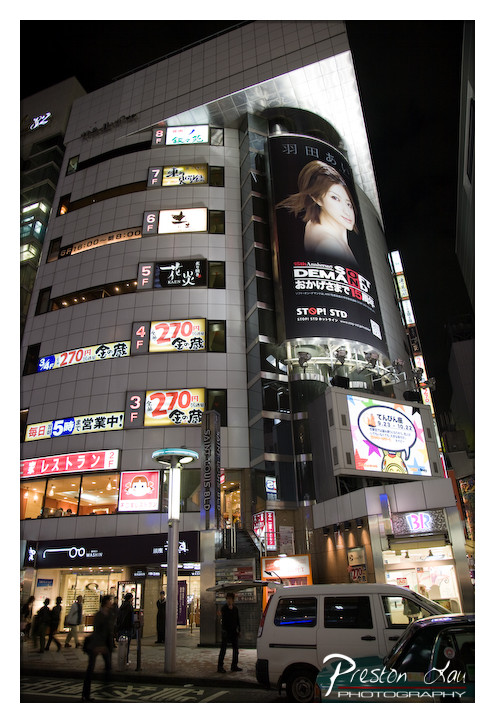

1. Overall Rating (0–10) — 6.8
This photograph captures the electric energy of a Japanese urban nightscape, where neon signs and digital billboards pulse with life against the dark sky. The towering building, adorned with glowing advertisements and Japanese text, conveys a sense of relentless commercial vibrancy. While the image effectively communicates the chaos and rhythm of city life, the visual overload risks overwhelming the viewer, and the composition’s cluttered feel slightly undermines its aesthetic cohesion.
2. Composition (0–10) — 6.0
The vertical framing emphasizes the height of the building, but the dense arrangement of signs and signage creates visual clutter. The placement of the van and pedestrian figures adds a sense of scale, though their positioning slightly disrupts the balance.
3. Lighting (0–10) — 7.5
The interplay of artificial neon and interior lighting creates a dynamic, high-contrast scene. The bright signs stand out sharply against the night, capturing the luminous character of the city, though some areas are slightly overexposed.
4. Color & Tone (0–10) — 6.5
The palette is dominated by cool whites and blues from the signage, punctuated by bursts of red, yellow, and pink. While vibrant, the lack of tonal harmony lends a somewhat chaotic feel, with colors competing for attention.
5. Creativity (0–10) — 7.0
The image successfully captures the unique character of a Japanese urban night scene, transforming a commercial facade into a visual narrative of modernity and consumer culture. The inclusion of the van and pedestrians adds a subtle human element, grounding the scene in reality.
6. Technical Quality (0–10) — 7.5
The photograph is sharp and well-exposed, with clear details in the signage and building façade. The long exposure captures the ambient light effectively, though some motion blur in the moving van is noticeable.
7. Emotional Impact (0–10) — 6.0
The image evokes a sense of urban energy and technological saturation, but its intensity may feel overwhelming rather than emotionally resonant. It captures the spectacle of the city without inviting deeper reflection or intimacy.
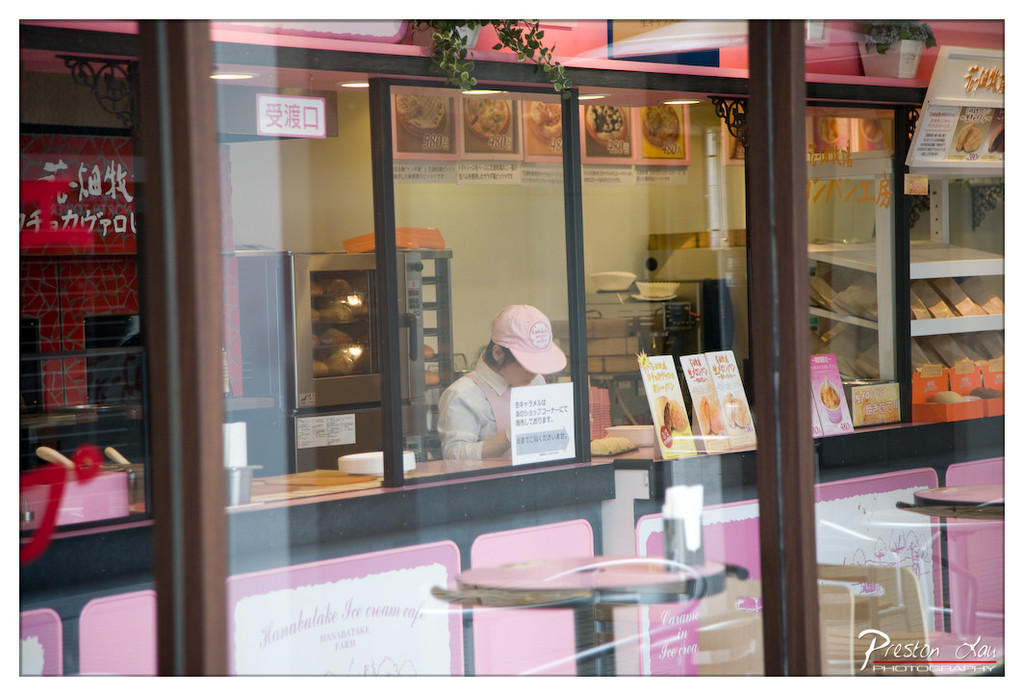

1. Overall Rating (0–10) — 7.0
This photograph captures the inviting warmth of a small Japanese café, where the soft glow of interior lights and the quiet presence of a staff member create a sense of gentle daily life. The layered reflections and glass barriers add a subtle complexity, hinting at the boundary between observer and participant. While the image feels authentic and narrative-driven, it lacks the visual punch of a more dynamic composition, remaining more observational than emotionally resonant.
2. Composition (0–10) — 6.5
The framing is balanced but slightly cluttered by reflections and foreground elements, which draw attention away from the central subject. The subject is well-placed, yet the overlapping layers of glass and signage create visual noise that disrupts the flow.
3. Lighting (0–10) — 7.0
The interior lighting is warm and inviting, casting a soft glow that enhances the cozy atmosphere. The contrast between the illuminated interior and the dimmer exterior adds depth, though the reflections on the glass slightly flatten the light’s impact.
4. Color & Tone (0–10) — 7.5
The dominant pink hues of the café’s branding create a playful, cohesive palette, while the warm yellow tones inside contribute to a sense of comfort. The color balance is consistent, though the reflections slightly mute the vibrancy of the scene.
5. Creativity (0–10) — 7.0
The image succeeds in capturing a candid, slice-of-life moment, using reflections and layers to suggest a story beyond the frame. The concept of viewing life through glass adds a layer of quiet introspection, making it more than just a simple snapshot.
6. Technical Quality (0–10) — 7.5
The image is sharp and clear, with good focus on the subject and readable text. The reflections, while slightly distracting, are a natural consequence of shooting through glass and do not significantly degrade the image’s clarity.
7. Emotional Impact (0–10) — 6.5
The photograph evokes a sense of calm and quiet routine, inviting the viewer to imagine the small rituals of daily life in a local café. While it doesn’t elicit a strong emotional response, it leaves a lingering impression of warmth and familiarity.


1. Overall Rating (0–10) — 6.8
This photograph captures a quiet, observational moment within a Japanese subway station, where a public service announcement stands as both a cultural artifact and a visual anchor. The poster’s bold yellow and black design contrasts sharply with the muted, institutional surroundings, drawing the eye while conveying a subtle commentary on social norms. While the image succeeds in documenting a slice of urban life, its potential is slightly diminished by the framing’s lack of compositional tension and the presence of distracting elements like the taped-over signage.
2. Composition (0–10) — 6.0
The poster is centered but partially obscured by a vertical pole on the left, which disrupts visual flow. The composition feels candid and unposed, with the right side’s taped poster adding visual clutter that weakens the balance. A tighter, more deliberate framing would enhance focus on the main subject.
3. Lighting (0–10) — 6.5
The lighting is flat and functional, typical of a subway environment—bright but without direction or warmth. It effectively illuminates the poster and surrounding tiles, but the lack of shadows or contrast reduces depth and atmosphere.
4. Color & Tone (0–10) — 7.0
The dominant yellow of the poster creates a strong visual contrast against the neutral white tiles, making it pop. The color palette is limited and utilitarian, with a slight yellow cast from the artificial lighting that unifies the scene, though it slightly flattens tonal variation.
5. Creativity (0–10) — 7.5
The image captures an unexpectedly poetic moment in a mundane setting—using a public health message as a lens into Japanese social etiquette. The juxtaposition of the illustrated scene (people behaving appropriately) against the real-world context adds a layer of irony and storytelling that feels both original and thoughtfully composed.
6. Technical Quality (0–10) — 7.5
The focus is sharp on the poster, with fine detail visible in the text and illustration. The depth of field is adequate, keeping the foreground elements slightly soft but still legible. The image is well-exposed, with no obvious technical flaws.
7. Emotional Impact (0–10) — 6.5
The photograph evokes a sense of quiet introspection, inviting the viewer to consider the unspoken rules that govern public behavior. While the emotional resonance is subtle, the cultural specificity of the message adds a layer of curiosity and slight amusement, creating a gentle connection with the viewer.
Loading map...